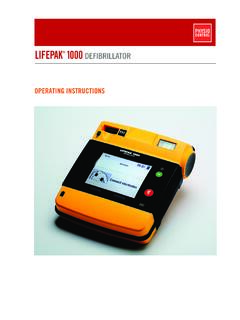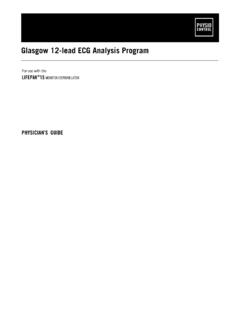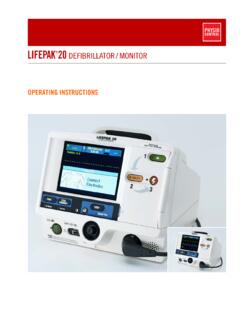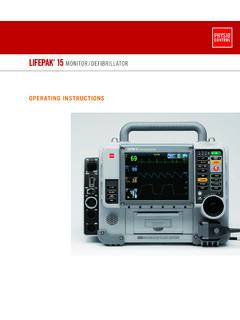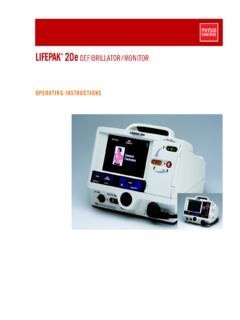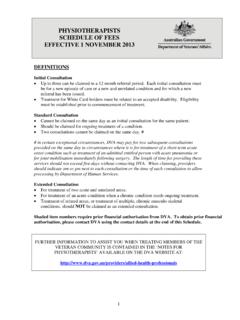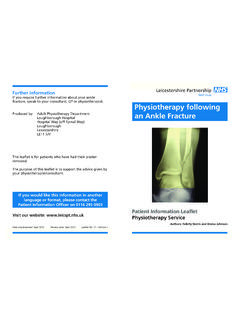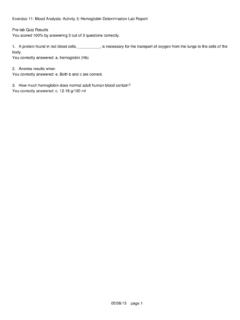Transcription of Training Answer Key and Annotated Test - Physio …
1 Training Answer Key and Annotated TestAll pages in the answers refer to the Instructions for Use (IFU)Instructions: Circle the correct responses and return to the instructor once you ve completed the test. 1. Which one of the following is NOT a contraindication for the LUCAS device use?a. A patient that is too small for the LUCAS deviceb. A patient with a closed head injuryc. If it s not possible to position the LUCAS device safely or correctly on the patient s chestd. A patient that is too large for the LUCAS deviceContraindications, Do NOT use the LUCAS Chest Compression System in these cases: If it is not possible to position the LUCAS device safely or correctly on the patient s chest. Too small patient: if the LUCAS device alerts with 3 fast signals when lowering the Suction Cup, and you cannot enter the PAUSE mode or ACTIVE mode.
2 Too large patient: If you cannot lock the upper part of the LUCAS device to the back plate without compressing the patient s chest. 2. When the battery indicator shows an intermittent yellow LED, the approximate operating time left is:a. 15 minutesb. 10 minutesc. 30 minutesd. 5 minutesOne intermittent yellow LED and alarm during operation: low battery, approximately 10 minutes of operating capacity remaining. 3. When applying the LUCAS device, what is your FIRST action upon opening the carrying case?a. Remove the back plateb. Check for a spare batteryc. Push ON/OFFd. Pull out the instructions for usePush ON/OFF on the User Control Panel for 1 second to power up the LUCAS device in the bag and start the self test. The green LED adjacent to the ADJUST key illuminates when the LUCAS device is ready for use.
3 4. All of the following are risks of incorrect pressure pad position EXCEPT:a. Damage to the rib cageb. Impairment of blood circulationc. Kidney failured. Damage to internal organsWARNING INCORRECT POSITION OVER CHEST. If the pressure pad is not in the correct position in relation to the sternum, there is an increased risk of damage to the rib cage and the internal organs. Also, the patient s blood circulation is compromised. 3 CHEST COMPRESSION SYSTEM 5. What should you do if the patient is too small for the LUCAS device?a. Put something, such as a blanket, between the patient and the back plateb. Remove the LUCAS device and provide manual chest compressions insteadc. Continue to use the LUCAS device despite the suction cup not being in contact with the chestd. Put something, such as a blanket, between the patient and the pressure pad of the suction cupWarning - too small patient.
4 If the LUCAS device alerts with 3 fast signals when lowering the Suction Cup, and you cannot enter the PAUSE mode or ACTIVE mode. Immediately start manual compressions again. 6. All of the following are examples of when to use the PAUSE button EXCEPT:a. During a short break in compressions; for example, during ECG analysisb. To change the battery during usec. To mute the alarmd. When moving a patient down stairs if the LUCAS device doesn t stay in the correct position and angle on the patient s chestWARNING ECG interference. Chest Compressions interfere with ECG analysis. Push PAUSE before you start the ECG analysis. Make the interruption as short as possible. Push ACTIVE (continuous) or ACTIVE (30:2) to start the compressions again. Changing the battery: Push PAUSE to temporarily stop the compressions.
5 Pull the battery out and then upwards to remove it. p. 22 The LUCAS device can be active while you move the patient if: a) the LUCAS device and the patient are safely positioned on the transportation device and b) the LUCAS device stays in the correct position and angle on the patient s chest. If necessary, adjust the position of the suction cup. WARNING - CHANGED POSITION DURING OPERATION. If the position of the Suction Cup changes during operation or during defibrillation, immediately push ADJUST and adjust the position. p. 21 7. How should the LUCAS device be positioned on the chest?a. The lower edge of the pressure pad inside the suction cup should be positioned immediately above the end of the sternumb. The lower edge of the suction cup should be positioned immediately above the end of the sternumc.
6 The lower edge of the suction cup should be positioned at a distance of two fingers from the lower end of the sternumd. The lower edge of the suction cup should be positioned at the nipple line of the patientWhen the pressure pad in the suction cup is in the correct position, the lower edge of the suction cup is immediately above the end of the sternum. 8. How should the suction cup be lowered to the patient s chest during adjustment?a. Use both hands and push as hard as you can until the pressure pad compresses the chestb. Use one hand (two fingers) and push down until the pressure pad touches the chest without compressing the chestc. Use both hands to lower as far as the pressure pad will god. Use one hand (two fingers) and push down making sure to leave a 2 inch space above the chestAdjust the height of the suction cup to set the start position: a) make sure the LUCAS device is in the ADJUST mode, b) push the suction cup down with two fingers until the pressure pad touches the patient s chest without compressing the chest.
7 9. All of the statements are true regarding the battery in the LUCAS device, EXCEPT:a. Press the PAUSE button before removing the battery while compressions are ongoingb. the LUCAS device will remember the current settings and start position for 60 seconds after the battery is removed c. You must power off the LUCAS device before removing the batteryd. The battery will last for approximately 45 minutes with a full chargeChanging the Battery: Push PAUSE to temporarily stop the compressions. Pull the battery out and then upwards to remove it. you change the battery quickly in 60 seconds or less, with the LUCAS device in the ON mode, the LUCAS Smart Restart feature remembers the settings and Start Position. If the battery change takes more than 60 seconds, the LUCAS device does a self test and you must adjust the Start Position again.
8 Battery runtime (nominal patient) 45 minutes (typical). 3 Training Answer Key and Annotated Test10. All of the following steps are done when moving a patient on the LUCAS device, EXCEPT:a. Reassess placement of the suction cup frequentlyb. Lift the patient using the wrist straps (patient straps)c. Attach the stabilization strapd. Secure the patient s wrists in the patient strapsCaution - do not lift by the straps. Do not use the straps for lifting. The straps are only to fixate the patient to the LUCAS device. (p 12) True or False:Bruising and soreness of the chest are common during the use of the LUCAS device True FalseThe International Liaison Committee on Resuscitation (ILCOR) states these side effects of CPR: Rib fractures and other injuries are common but acceptable consequences of CPR given the alternative of death from cardiac arrest.
9 After resuscitation, all patients should be reassessed and re evaluated for resuscitation related injuries. Apart from the above, skin abrasions, bruising and soreness of the chest are common during the use of the LUCAS Chest Compression System. battery does not have to be inserted into the LUCAS device when it s running on AC power. True FalseCaution keep battery installed. The battery must always be installed for the LUCAS device to be able to operate, also when powered by the external power supply. check to make sure the position of the suction cup is correct after defibrillation. True FalseAfter defibrillation, make sure that the position of the Suction Cup is correct. If necessary, adjust the position. the battery change takes more than 60 seconds, the LUCAS device does a self-test and you True False must adjust the start position : If the battery change takes more than 60 seconds, the LUCAS device does a self-test and you must adjust the start position again.
10 A fully charged spare LUCAS device battery should always be in the carrying case. True FalseTo minimize interruptions, we recommend to always have a charged spare LUCAS device battery in the carrying case. s okay for the defibrillator electrodes and wires to be under the suction cup. True FalseCaution defibrillation electrodes. Position the defibrillator electrodes and wires so they are not under the suction cup. If there are already electrodes on the patient, make sure they are not under the suction cup. If they are, you must apply new electrodes. LUCAS device is intended for performing external cardiac compressions on adult patients True False in cardiac use, LUCAS Chest Compression System is to be used for performing external cardiac compressions on adult patients who have acute circulatory arrest defined as absence of spontaneous breathing and pulse, and loss of consciousness.
